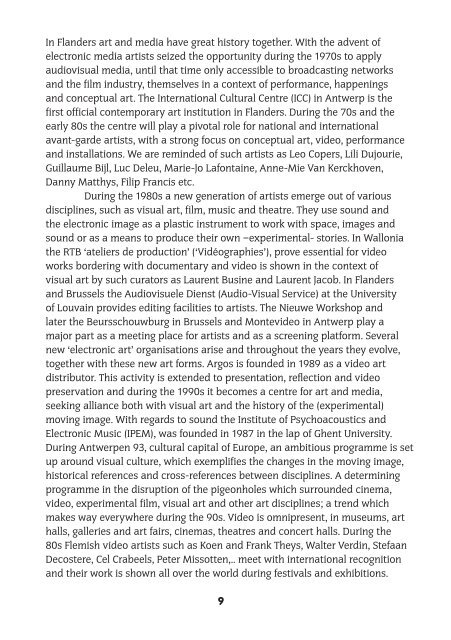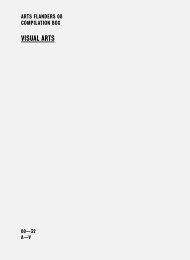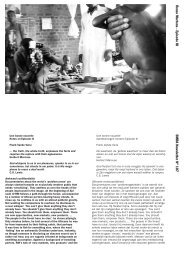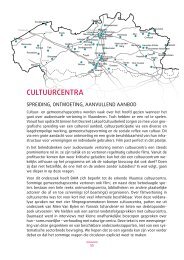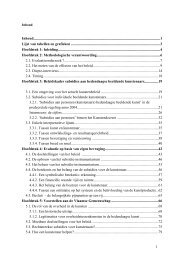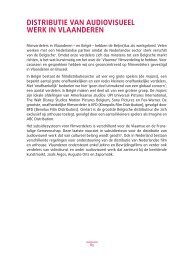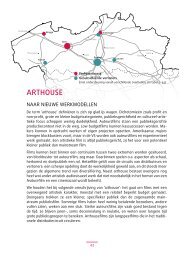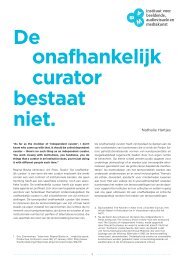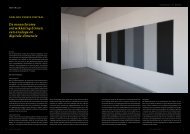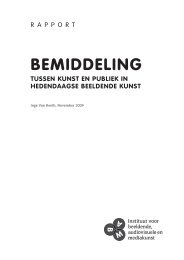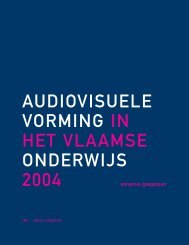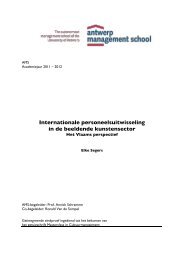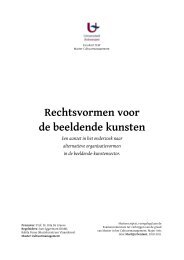MEDIA DIGITAL ART AND CULTURE IN FLANDERS BELGIUM - BAM
MEDIA DIGITAL ART AND CULTURE IN FLANDERS BELGIUM - BAM
MEDIA DIGITAL ART AND CULTURE IN FLANDERS BELGIUM - BAM
Create successful ePaper yourself
Turn your PDF publications into a flip-book with our unique Google optimized e-Paper software.
In Flanders art and media have great history together. With the advent of<br />
electronic media artists seized the opportunity during the 1970s to apply<br />
audiovisual media, until that time only accessible to broadcasting networks<br />
and the film industry, themselves in a context of performance, happenings<br />
and conceptual art. The International Cultural Centre (ICC) in Antwerp is the<br />
first official contemporary art institution in Flanders. During the 70s and the<br />
early 80s the centre will play a pivotal role for national and international<br />
avant-garde artists, with a strong focus on conceptual art, video, performance<br />
and installations. We are reminded of such artists as Leo Copers, Lili Dujourie,<br />
Guillaume Bijl, Luc Deleu, Marie-Jo Lafontaine, Anne-Mie Van Kerckhoven,<br />
Danny Matthys, Filip Francis etc.<br />
During the 1980s a new generation of artists emerge out of various<br />
disciplines, such as visual art, film, music and theatre. They use sound and<br />
the electronic image as a plastic instrument to work with space, images and<br />
sound or as a means to produce their own –experimental- stories. In Wallonia<br />
the RTB ‘ateliers de production’ (‘Vidéographies’), prove essential for video<br />
works bordering with documentary and video is shown in the context of<br />
visual art by such curators as Laurent Busine and Laurent Jacob. In Flanders<br />
and Brussels the Audiovisuele Dienst (Audio-Visual Service) at the University<br />
of Louvain provides editing facilities to artists. The Nieuwe Workshop and<br />
later the Beursschouwburg in Brussels and Montevideo in Antwerp play a<br />
major part as a meeting place for artists and as a screening platform. Several<br />
new ‘electronic art’ organisations arise and throughout the years they evolve,<br />
together with these new art forms. Argos is founded in 1989 as a video art<br />
distributor. This activity is extended to presentation, reflection and video<br />
preservation and during the 1990s it becomes a centre for art and media,<br />
seeking alliance both with visual art and the history of the (experimental)<br />
moving image. With regards to sound the Institute of Psychoacoustics and<br />
Electronic Music (IPEM), was founded in 1987 in the lap of Ghent University.<br />
During Antwerpen 93, cultural capital of Europe, an ambitious programme is set<br />
up around visual culture, which exemplifies the changes in the moving image,<br />
historical references and cross-references between disciplines. A determining<br />
programme in the disruption of the pigeonholes which surrounded cinema,<br />
video, experimental film, visual art and other art disciplines; a trend which<br />
makes way everywhere during the 90s. Video is omnipresent, in museums, art<br />
halls, galleries and art fairs, cinemas, theatres and concert halls. During the<br />
80s Flemish video artists such as Koen and Frank Theys, Walter Verdin, Stefaan<br />
Decostere, Cel Crabeels, Peter Missotten,.. meet with international recognition<br />
and their work is shown all over the world during festivals and exhibitions.<br />
9


